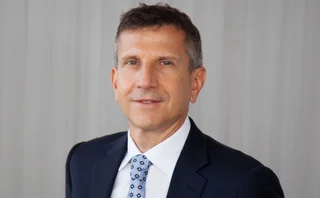
Technology - Build or buy - To build or buy?
Today's complex energy markets mean the traditional decision of whether to build or buy trading and risk management software systems has never been more important, writes Mark Raine
Operating in today's booming, but highly complex, energy markets requires a greater commitment to planning and building trading and risk management systems than ever before, particularly for financial institutions. Competition is rife, and companies need to retain and expand their corporate client base by offering a wider range of products via proprietary channels.
In the past, financial institutions such as investment banks, hedge funds and pension funds have been able to enter the energy and commodities market, then exit reasonably cleanly and cheaply when there has been a downturn. This time around, due to the increased complexity of trading in these markets, they will need to take a much more long-term and strategic view of their market participation - and most particularly, their systems deployed to facilitate this.
Rapid market transition
The markets in Europe in particular are in rapid transition. The gas market is moving from a system of closed nationalised gas industries towards the EU goal of a single, open and competitive market. Meanwhile, the European power trading market saw its best volumes ever in 2005, led by strong growth in Germany. Additional attractions for global banks are the ability to trade all over Europe as formerly closed markets open up.
The greater use in trading of cross-commodity and high-value structured products means that the banks will no longer be able to shoehorn trades into off-the-shelf packages with relative ease. The increased buy-side knowledge of structured products means that investment banking customers have quite fixed risk and return requirements that need to be catered for. Some in-house development, vendor customisation or the use of third-party toolkits will, therefore, be required in order merely to capture trades. Further custody of the trade during its full life cycle will take even more work.
The increasing derivatisation of the markets and use of crack spreads in oil, spark spreads in gas and power, and the complexity of swing trades in gas are all examples that show that the traditional position and risk management packages are not adequate to fulfil the analytics requirements for cross-commodity risk. Therefore many participants are having to invest in either custom-made solutions or very specialised packages.
Commodities systems that are based upon foreign exchange (FX) methodology are now completely unsuitable for energy, and the volatilities experienced recently alone have borne this out. For some banks, this means looking at their second generation of energy trading systems, and this may require a great leap forward in terms of product coverage. The requirement for hourly and sub-hourly trading for European power, for example, is a functional requirement that banks will not have come across in their existing treasury systems.
Another consideration is that energy trading desks can be quite small by comparison with financial markets, but the investment required per trader is higher than any other asset class due to both demand and complexity. In order to get a greater return on investment, most banks will also want to capture their functional requirements for metals, softs and other commodities in their 'energy' system.
Also, unlike the treasury markets, the European energy markets are still quite local and distinct in nature, making it vital to have operational experience in each of the markets traded. This will demand further system configuration. Furthermore, the likely increase in cross-border trading and subsequent cross-currency differentials will give rise to a perceived increase in credit risk, and where non-Eurozone countries are involved, inherent FX risk.
The wide variety of the energy markets, the products and the swaps between products, all with different trading parameters, means that any system implementation is likely to be hugely complex. The integration of off-the-shelf energy trading packages into internal or external systems and processes will add further complexity, and requires extensive system configuration. It is this configuration that will be the key to a successful implementation, ensuring that the system is deployed in a way that accurately reflects the trading requirements of the organisation and the time-to-market expectations for new products.
Banks also require system flexibility and therefore maximum configurability in order to future-proof systems against further functional requirements. This means that they need to be designed for maximum re-use wherever possible. The banks also need to consider scheduling requirements for oil, gas and power, as there are very punitive default fees imposed by regulators for physical non-delivery. This requires a specific systems module or a development, and this will need to be integrated at the time of the main systems implementation.
However, there are also a number of conflicting generic requirements. The fallout from the collapse of Enron, a zero-tolerance culture for compliance issues, and requirements from Sarbanes Oxley and FAS 133/IAS39 all suggest the need for a retreat from the spreadsheets and manual procedures beloved of the trader.
However, the demand for more high-value structured products and more complex derivatives creates the need to formally embed spreadsheet pre-trade calculations within an overall trading systems requirement. In Europe, the impact of Mifid also needs to be considered, as commodities are classed as 'in scope' for the initiative.
Perhaps most importantly, however, in order to gauge the overall risk for energy, institutions need to be able to view all of the underlying component risks in one system. This is not always possible, as these components can be stored in various systems. For example, the overall risk for power trading should include elements of weather, gas and emissions, as well as the power component itself.
Therefore, without the ability to run the VAR for all of the aforementioned components in one place, it will not be possible to create a full hedge. To resolve this will take a considerable commitment to systems planning.
If we assume that there is currently an average 12-month cycle from the start of a systems selection process through to full implementation, within this apparently long period there is paradoxically a relatively short window for getting the configuration plan right. Traders, middle office, back office etc may well be experiencing 'system requirement fatigue' at the end of the due diligence process. However, it is vital that the team can remain sharply focused during the configuration phase in order for the implementation to be successful. The deployment of a 'B team' at this crucial stage could be disastrous.
No off-the-shelf solution
Effectively this means that there is never going to be a completely off-the-shelf package for energy, and that resource issues will require as much planning as technical and functional ones. Today's trading complexity means that for investment banks to enjoy the sustained fruits of the energy boom, the need to enhance time-to-market for new products will be a crucial factor.
The traditional buy or build decisions will, therefore, be more important than ever. It will be those institutions that take a strategic view rather than a tactical approach to energy systems deployment that are able to make the most of the market's opportunities for reward over the long term.
Mark Raine is an energy and commodities consultant at Stentra. Email: mraine@stentra.com.
Only users who have a paid subscription or are part of a corporate subscription are able to print or copy content.
To access these options, along with all other subscription benefits, please contact info@risk.net or view our subscription options here: http://subscriptions.risk.net/subscribe
You are currently unable to print this content. Please contact info@risk.net to find out more.
You are currently unable to copy this content. Please contact info@risk.net to find out more.
Copyright Infopro Digital Limited. All rights reserved.
As outlined in our terms and conditions, https://www.infopro-digital.com/terms-and-conditions/subscriptions/ (point 2.4), printing is limited to a single copy.
If you would like to purchase additional rights please email info@risk.net
Copyright Infopro Digital Limited. All rights reserved.
You may share this content using our article tools. As outlined in our terms and conditions, https://www.infopro-digital.com/terms-and-conditions/subscriptions/ (clause 2.4), an Authorised User may only make one copy of the materials for their own personal use. You must also comply with the restrictions in clause 2.5.
If you would like to purchase additional rights please email info@risk.net
More on Awards
Environmental products house of the year: ENGIE
ENGIE is driving change in energy transition, with a strong focus on renewable energy and the liberalisation of power markets in Apac, which presents significant long-term growth opportunities. In recognition of its efforts, ENGIE GEMS has been named…
Natural gas/LNG house of the year: ENGIE
ENGIE continues to expand its services to better serve firms in Apac dealing with the challenges of energy risk management and supply
FRTB management solution of the year: Bloomberg
Amid the diverging timeframes and complex requirements of FRTB, Bloomberg offers a consistent, comprehensive and customisable solution for Apac banks preparing for implementation
Newcomer of the year: Topaz Technology
Jon Fox and former colleagues formed Topaz Technology in 2015. Having seen many different systems and, in some cases, written and built a few themselves, there was always something missing, leading them to build a system that unifies risk reporting and…
Technology vendor of the year: Murex
As a technology vendor, Murex places adaptability front and centre of everything it does, constantly enriching its MX.3 platform to ensure institutions can respond to new market opportunities as soon as they spot them
Currency derivatives house of the year: Deutsche Bank
Asia Risk Awards 2024
Interest rate derivatives house of the year: Standard Chartered Bank
Asia Risk Awards 2024
Derivatives house of the year, Taiwan: CTBC Bank
Asia Risk Awards 2024







